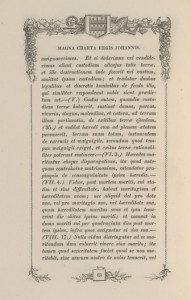June 15, 2015, by Kathryn Steenson
Celebrating Magna Carta
Eight hundred years ago today, King John affixed the Great Seal to Magna Carta, after a week of intense negotiations with the group of barons who had rebelled against his reign.
It is probably one of the most famous failed peace treaties in history. Like his father and older brother before him, John believed the divine right of monarchs to rule put them above the law. The nobility, however, preferred monarchs to respect the country’s customs and laws, and to seek counsel from leading clerics and landowners. John’s personality only exacerbated this difference in attitude. His contemporaries regarded him as petty, cruel, and impious. His numerous foreign military campaigns were an enormous financial burden on the country and – as anyone familiar with the legend of Robin Hood knows – John increased the existing taxes and introduced new ones to pay for them.
By 1215 the dissatisfaction with John’s rule had been growing for several years. The rebel barons who united against him felt their only option was military action, and took control of London, Lincoln and Exeter in the May. John was left with little choice but to negotiate, with the Archbishop of Canterbury acting as mediator.
 Magna Carta was the result of those peace talks held at Runnymede, Surrey. Very few 13th century documents survive, and only four copies of the original 1215 charter survive: two in the British Library and one each in the cathedrals of Lincoln and Salisbury. John’s reign saw a great deal of improvement of administrative record-keeping but we only have a couple of documents dating from his reign. This deed (Mi D 4650), held on deposit here, is dated March 1201. It is a notification that the king has given and granted to William de Stuteville licence to close and fortify William’s houses at Cottingham and Buttercrambe. The seal has been damaged but the parchment is in extremely good condition, with the words “Iohannes Dei gratia rex” (John, King by the Grace of God) clearly visible at the start. More images and a full translation of the deed are available from The Magna Carta Project.
Magna Carta was the result of those peace talks held at Runnymede, Surrey. Very few 13th century documents survive, and only four copies of the original 1215 charter survive: two in the British Library and one each in the cathedrals of Lincoln and Salisbury. John’s reign saw a great deal of improvement of administrative record-keeping but we only have a couple of documents dating from his reign. This deed (Mi D 4650), held on deposit here, is dated March 1201. It is a notification that the king has given and granted to William de Stuteville licence to close and fortify William’s houses at Cottingham and Buttercrambe. The seal has been damaged but the parchment is in extremely good condition, with the words “Iohannes Dei gratia rex” (John, King by the Grace of God) clearly visible at the start. More images and a full translation of the deed are available from The Magna Carta Project.
Several days after John formally agreed to Magna Carta, the barons swore an oath of allegiance to him. Neither side trusted the other, and within a few months the fragile peace had disintegrated. The conflict was cut short by John’s death following year. A slightly revised version Magna Carta was resurrected, in the name of his 9-year old son Henry III, as a means of gaining the support of the barons for the new King.
Magna Carta was reissued several times with updates and revisions and despite its iconic status as a rallying cry for British rights, only three of the original 63 clauses are still relevant today, including probably the most famous clause (39) that established the right to a fair trial. Other clauses either have no real importance to modern society (such as fish weirs in the Thames) or have been superseded by modern legislation, such as tax law and the standardisation of weights and measures.
The images below are extracts from Richard Thomson’s An historical essay on the Magna charta of King John (London, 1829) (Ref: Special Collection JN147.T4), and fall into the latter category. Under the terms of Magna Carta, the King could not force a widow to remarry, although in reality this had only ever applied to the nobility. Widows without wealth or property were of little interest to the monarch. It wasn’t complete freedom, as the King could still withhold permission for the widow to remarry the man of her choice, but his ability to control the transfer of deceased barons’ estates to his supporters was curtailed. In many ways this illustrates why Magna Carta has assumed such importance over the centuries, even though so many of the clauses are no longer on the statue book: it was a start, the first attempt at enshrining the principles of liberty, equality in law, and accountability of rulers to the people.
For more information about Magna Carta, please see the British Library’s dedicated online resource. For more information about our holdings, please visit our website. You can also follow us on Twitter @mssUniNott.
No comments yet, fill out a comment to be the first




Leave a Reply